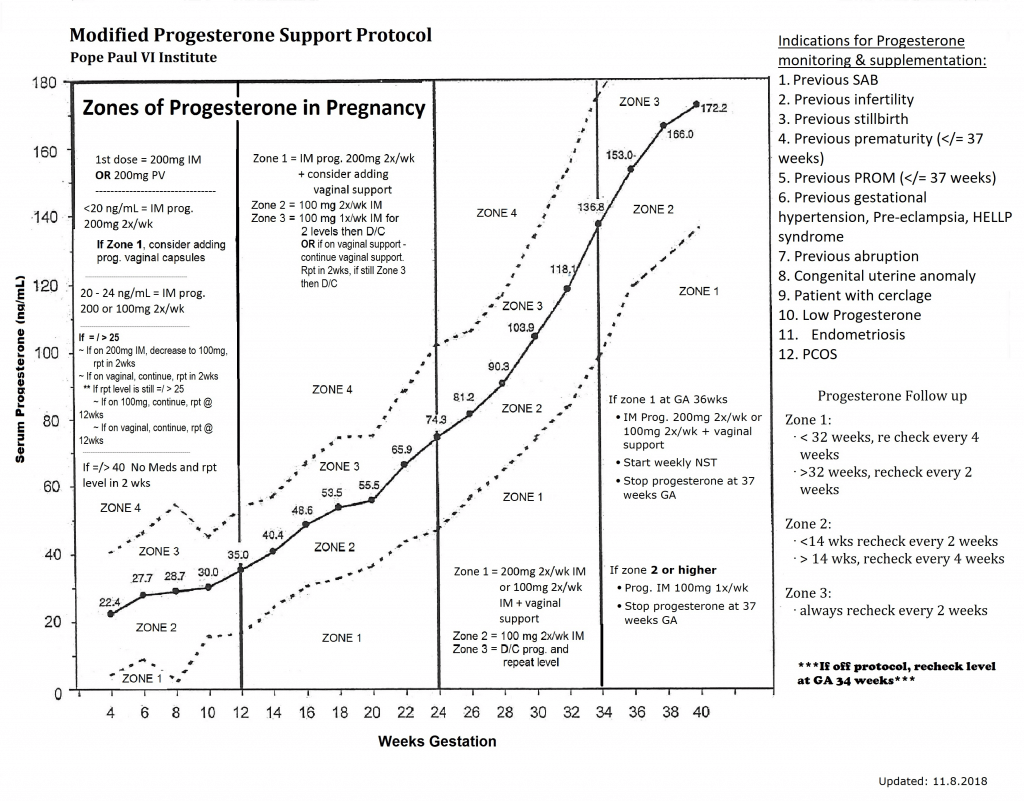Progesterone in Pregnancy
We suggested you have your progesterone level checked because you have a history that is suggestive of low progesterone and/or there is something about your current pregnancy indicating a possible progesterone deficiency. The lab results have returned and we’ve suggested progesterone therapy, which has understandably created some questions on your part.
This document is intended to help you understand the biology and the philosophy behind our recommendation for progesterone supplementation therapy. It is no substitute for a face-to-face conversation with us, but it is intended to expedite the process and get you started on the therapy we believe you and your baby need as quickly as practical.
As with every aspect of your care, the decision of what is best for you and your baby is yours to make. We are recommending that you begin progesterone supplementation therapy, but if after reviewing this material you are not comfortable initiating therapy and/or you would prefer waiting until you can discuss it with one of the providers by phone or in person, we will respect your decision accordingly.

We’ve known for decades that progesterone plays a vital role in the maintenance of a healthy pregnancy and as part of Drs. Stroud and Stalling’s training as certified Creighton Model FertilityCare™ Medical Consultants they believe in closely following progesterone levels in all pregnancies known to be at risk for complication. This is a markedly different approach from that of most obstetricians and fertility specialists in the area.
Progesterone Studies
The National Hormone Laboratory at the Pope Paul, VI Institute for the Study of Human Reproduction in Omaha, Nebraska (popepaulvi.com) where Dr. Stroud, Dr. Stalling, and Dr. Grosvenor received their fertility certification has decades of data that depict women’s progesterone levels throughout the course of a normal pregnancy. By analyzing this data, we are able to understand the progesterone level in a healthy pregnancy at every point that pregnancy. By contrast, we are also able to look at pregnancies with common complications and understand what the progesterone levels are in those pregnancies at various points along the developmental path.
As one might expect, in the abnormal pregnancies with complications such as preterm rupture of membranes, early miscarriage, preterm birth, and placental abruption, the progesterone levels are low at almost every point throughout the pregnancy. The simple fact is, progesterone is critical to developing and maintaining a normal, healthy pregnancy. Of course, it is not alone in this role, but it is nonetheless, a key component and without it, serious complications occur. Most important, when we correct a low progesterone level; that is, when we bring the progesterone level up to the normal level, we dramatically reduce the number of complications. This fact has been supported by numerous published research studies throughout the scientific literature in recent years.
Supplementing Progesterone
How we go about supplementing progesterone varies. There are some who suggest taking oral progesterone. Others suggest taking vaginal suppositories, and still others suggest creams and/or injections. The Creighton Model FertilityCare™ protocol prescribes a dose and route of progesterone therapy based on the level of progesterone detected in blood tests. As the pregnancy progresses and (hopefully) the progesterone level rises, it is often possible to decrease the dose and frequency of the progesterone therapy and, in many cases stop supplementation altogether.

Why an injectable progesterone?
We’re often asked why we use injectable progesterone instead of oral forms of the hormone. Progesterone has what in pharmacology is known as a high “first pass effect.” That is, when taken orally, it enters the intestinal tract and then the bloodstream, and then goes to the liver—this is the normal pathway for most medications and nutrients. The vast majority of progesterone is metabolized by the liver as it passes through the first time from the intestinal tract and this is known as the “first pass effect.” As a result, there is very little of the progesterone left to exert its effect on the target organ (in this case, the uterus) once it passes through the liver.
By contrast when progesterone tablets are placed in the vagina, they are slowly absorbed through the walls of the vagina into the bloodstream and circulate in and around the blood vessels of the uterus before eventually making it to the liver. When progesterone is injected into the muscle in an oil base, it is even more slowly absorbed into the bloodstream, circulating around the body and exerting its effect before making it to the liver where it is metabolized.
So our strongest progesterone delivery tool is injectable; our next best tool is a vaginal tablet, and our least effective tool is the oral tablet.
Bio-Identical Progesterone
We only prescribe what is known as, “Bio-identical” natural progesterone. That is, the progesterone is in every way—biochemically, biologically, pharmacologically, and structurally—identical to the progesterone produced by the human body. Some bottles of progesterone (Prometrium, for example) may have package inserts warning of the possibility of birth defects with the use of this medication. This warning refers to artificial progesterone substitutes (typically called progestins, a common ingredient in oral contraceptives) and not the pure, bio-identical progesterone that we prescribe. The Pope Paul, VI Institute has decades of experience using bio-identical progesterone in pregnancy and has no reported problems resulting from its use. We feel completely comfortable prescribing its use during pregnancy.

Depending on the specifics of your clinical circumstance you may already be taking vaginal progesterone or you may be just starting it for the first time after reading this document. More than likely, it is being recommended that you begin twice weekly injection therapy, possibly in addition to daily vaginal therapy, while we await the lab results.
Bio-identical progesterone is generally very well tolerated with few side effects. It is common to experience soreness at the site of an injection. Using the technique described in the teaching materials is essential to minimizing discomfort at the injection site. Applying vitamin E oil can often relieve itching at the injection site.

Click here to view printable Progesterone in Pregnancy information.
